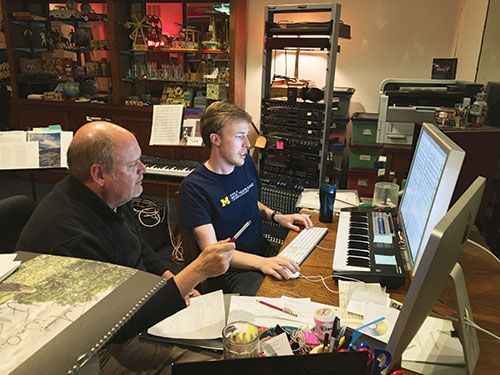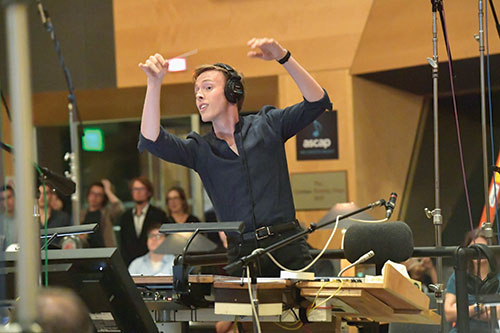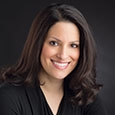Composer Jules Pegram’s music has been performed by the New World Symphony, the Cabrillo Festival Orchestra, the American Composers Orchestra, Symphony in C, the Naples Philharmonic, and the Indianapolis Symphony Orchestra, among others, and has been recorded by the Hollywood Studio Symphony at Warner Bros. Studios and 20th Century Fox Studios in Los Angeles.

photo by r.r. jones
How did you become a composer?
I started writing by the end of middle school but had a composer’s mindset even earlier than that. Like many, my first real musical memory was seeing those epic yellow credits crawl at the beginning of Star Wars, which I was lucky enough to experience on the big screen with my dad during the 1997 theatrical re-release. Even as a six-year-old, I was floored by John Williams’s soaring score, and though I didn’t yet know how, I realized that sort of cinematic orchestral music would be central to my life.
I grew more and more interested in music throughout elementary school, well beyond our weekly general music class. One day after school, I walked by the music classroom and heard the teacher, Lynn Burgess, playing the piano. I don’t know what prompted a second-grade me to do this, but I knocked on the door and asked if she could teach me piano lessons. She contacted my mom, and I ended up studying with Ms. Burgess for a year after school. At that point, I learned to play piano primarily by ear, parroting what she demonstrated at the keyboard. Reading musical notation would come about a year later.
Ms. Burgess made a huge impact because, in addition to our class time and those regular piano lessons, she introduced me to the CD recording Beethoven at Bedtime, produced by the Philips Classics Series. I was hooked. I ended up devouring most of that Philips, from Debussy for Daydreaming to Mozart for Meditation. Christmas and birthdays meant trips to the record stores, and long car rides meant the chance to listen for hours on my Walkman. I became obsessed with classical music.
By sixth grade, I had studied piano with several different teachers, but I wanted to learn a new instrument and join a large ensemble. Middle school band meant playing alongside my friends for the first time, and I ended up playing trumpet and later horn. I became interested in how all the other lines were put together, and started trying to decipher how a composition is constructed.
That’s unusual for someone that age.
It is difficult to describe how intensely I got into composition. I downloaded an early music notation software, but it only allowed for scoring up to eight instruments. My parents soon ordered me the full version of Finale, and later, Sibelius. It wasn’t until college that I retooled again and started writing with pencil and paper at the piano. The notes end up engraved in Sibelius, but I still flesh out my music by hand.
You recently won the ASCAP/CBDNA Frederick Fennell Prize for your Concerto for Alto Saxophone & Wind Ensemble. What prompted you to write this piece? How would you describe the work to someone who might be considering performing it?
I owe this piece and its inspiration to Andrew Harrison, a friend and classmate from my USC days. After hearing my music in school, he asked me first to write a Sonata for Alto Saxophone and Piano. I was studying with Bruce Broughton, a wonderful composer famous for scores like The Rescuers Down Under and Silverado. At one lesson, I brought in my big sketch pad of musical scraps and early ideas. Bruce always supported my music, but none of that day’s sketches seemed to gel. He carefully scanned the pad for a while before spotting this little motif at the bottom of the page. It was so slight that I almost hadn’t bothered to write it down. I still don’t know how he knew that idea had potential, but he insisted I play it at the piano and said it was catchy and worth exploring.
This was yet another of the countless gifts I owe to a teacher: Bruce’s eye for quality and care in selecting initial material helped me see the potential of that tiny fragment, inspiring me to churn out the entire sonata in less than two weeks. That motif became the primary theme of the work’s final movement, and it’s the tune people most remember and hum after hearing the piece.
Andrew encouraged me from the beginning to focus on writing bold, cantabile lines that he could really sing out. As I played through the early sketches with him, I realized what a broad, rich sound he could produce; just as easily, he could achieve these intimate, breathy pianissimos. This led to me writing a two-part sonata in which line is paramount. The first movement is inspired by the hushed pathos of an imagined film noir score, while the subsequent finale is sunny and soaring. A couple of years later, I revisited the piece and fleshed it out to a more traditional three-movement sonata. Adding a new first movement with a flashy cadenza allowed me to delve into some highly virtuosic material for the saxophone, and I scored this opening (I. Con bravura) with an edgier musical heft than the latter two movements; it was important to earn the more sentimental interior movement (II. Grave, molto rubato) and the lighthearted final movement (III. Vivacissimo).
As for the expansion of the work into a full-scale concerto with wind ensemble, I again owe so much to Andrew. Last year he approached his colleague Greg Whitmore, an incredible conductor and fellow Michigan alum who’s now at the helm of several southern California college bands, in addition to the renowned Pacific Symphony Youth Wind Ensemble (PSYWE). Andrew connected all of us and introduced Greg to my music. This led to the commission of my concerto by the PSYWE and Mt. San Antonio College, and to the March 2019 premiere of the work in the Pacific Symphony’s beautiful Segerstrom Hall in Costa Mesa, California.

photo by Yopie Prins
What is your approach to writing for winds? Are there models or composers you look to when writing for winds?
I am disheartened when I hear composers discuss writing for band in business terms, as something advantageous to pursue mainly because there are so many bands and more opportunities for performance. I wish more composers talked about band’s incredible capacity for warmth and drama, about the humanness you get with instruments entirely dependent on breath.
For me, the most exhilarating thing about wind ensembles is the chance to explore color, from the sonorous, huge brass family to the organ-like clarinets to the brilliance of the flute choir and the reediness of saxophones and oboes and bassoons. All that color means challenging orchestration, made more difficult by varying band sizes and instrumentation. I remember Bruce Broughton’s wise observation, “The tough thing about orchestrating for band is that you never know who’s going to show up.”
I don’t think of the band as a sibling to the orchestra. I’m never thinking how I can best simulate the strings. I am more concerned about handling the choirs and families, of voicing chords and seeking out ways to achieve true sustain, something far more difficult in band-writing than orchestral. It’s one reason I often gravitate towards moving textures or active lines when I write for winds.
I learned so much about wind ensembles by playing piano in the University of Michigan Symphony Band under the direction of Michael Haithcock during my Master’s, and then studying conducting with him during my doctorate. It was the most incredible window into one of the most storied band programs in this country.
I’d be remiss not to mention my high school band director, Ed Kimbrough. He was an amazing educator who taught us about the history of the wind ensemble. We learned the legacy of Fred Fennell, the Eastman Wind Ensemble, the recordings, all those important milestones. Receiving the ASCAP/CBDNA Frederick Fennell Prize wasn’t just cool because of the prize itself, but because I had known who Fred Fennell was since I was a freshman in high school. We played so much important literature because of Mr. Kimbrough. Early on, I was exposed to Alfred Reed’s Armenian Dances and Russian Christmas Music, the Holst suites, Percy Grainger, John Barnes Chance, and Malcolm Arnold. We played living composers from Libby Larsen to Eric Whitacre.

photo by ASCAP
Which living composers do you most admire?
Perhaps more than any single composer, I owe so much to the many composers I have studied with. In choosing where I applied to school, this was by far the most important consideration. From Morten Lauridsen and Frank Ticheli I learned the importance of musical economy and rigorous craftsmanship; from Erica Muhl I learned the values of strong musical conviction and of deep, intensive study into the history of our art form; a better understanding of architecture and musical structure were gifts from Bright Sheng; and Evan Chambers helped me explore the psychology and inner essence of my music. From my primary mentor and advisor, Michael Daugherty, I learned everything from micro and macro orchestration to pacing to score preparation to communicating with an orchestra or navigating rehearsals – treasured wisdom from a model composer and teacher.
As for other living composers, I’m just as likely to be found listening to contemporary classical and film music as I am to jazz icon Maria Schneider, singer-songwriter Sufjan Stevens, Reba McEntire, Post Malone, or rural folk pianist George Winston. Lately I’ve been absorbing the output of the unbelievably prolific Jerry Goldsmith. Although he died in 2004, his music feels alive and vibrant, and his influence on today’s film scoring is profound. I can think of no composer who worked on more mainstream films with as innovative and perfectly cinematic a voice as Jerry’s. Goldsmith and John Williams are my two greatest heroes.
What pieces for younger players are in your catalog?
Several years ago, I transcribed for band my orchestral work Neon Nights, a wild celebration of South Beach, Miami. The orchestral version has been performed by the New World Symphony and the Indianapolis Symphony, and I hope this newer band version will reach even more groups. Although its challenges might seem to lie in the independence of its instrumental parts, in reality things are idiomatically scored and specifically designed so that the collective sum is much more complex than any one part. A strong high school band could definitely tackle it.
What would you like conductors and educators to know about commissioning music and working with composers?
My answer may surprise you, but I have noticed there is often too much latitude given to the composer. Being asked to compose whatever you want can sometimes be overwhelming, leading to aimless writing. Composers, in my experience, tend to work better with guidelines and stipulations. I live by that great Stravinsky quote from Poetics of Music: “The more constraints one imposes, the more one frees one’s self of the chains that shackle the spirit.”
While it is crucial to be open and supportive, I encourage any commissioner to ask for specifics. If you want a slow and lyrical and romantic piece, it is appropriate to use that language right from the beginning. Do not worry about constraining a composer’s artistry merely by suggesting a vague style or concept. For example, when Andrew Harrison and I set out to create a new saxophone concerto, we discussed how many composers seem interested in writing only the most technically demanding music for the instrument. After all, today’s saxophonists are comfortable playing works of wild difficulty. Andrew was hungry to play something that is a rarity these days: a true melody. That’s the primary reason I wrote a big arch of a tune at the heart of my concerto.
For educators, look for any chance to encourage budding composers in the classroom, and never be afraid to share lessons learned from your years on the podium. Remember, too, that the greatest gift for a young composer is to hear their music played their classmates.
What advice would you give to aspiring young composers?
Listen just as much as you write. Be a lifelong student of history. Be wide-eyed and present, aware of the latest trends and the current innovators. Never compromise your vision for what others think you should write. Never stop honing your craft. Actively avoid artistic dogma. Cherish the process. Develop a thick skin. Protect your brand. Do honest work.
For more information, please visit www.julespegram.com.






